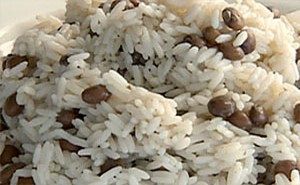 Rice is rich in starch, and an excellent source of energy. Beans are rich in protein, and contain other minerals. The consumption of the two together provides all the essential amino acids and it is no wonder that this combination is a staple of many diets throughout the world.
Rice is rich in starch, and an excellent source of energy. Beans are rich in protein, and contain other minerals. The consumption of the two together provides all the essential amino acids and it is no wonder that this combination is a staple of many diets throughout the world.
Here’s why they are an excellent combination for long-term survival food starge…
Although you will likely add additional ingredients with rice and beans, having just…
(1) 5-gallon pail of white rice (1) 5-gallon pail of pinto beans
…will provide 44 days of ‘survival’ calories. That’s a month and a half worth of food!
Sure, you won’t want to eat rice and beans every day, every meal, and the recommended practice for building food storage for survival preparedness is to diversify…
However, it is wise to consider securing a basic supply of rice and beans, properly packed and stored for long term storage, so that you will have a ready inventory of ‘fall-back’ food storage. It is cheap, healthy enough, and will last for many years if stored properly.
There are lots of other foods and spices that can be easily and tastily added to rice and beans, making it a very good base for meals – a base that could technically sustain you even if that’s all you had to eat.
Consider buying yourself some bulk rice and beans, and store them properly, just in case.
Long Grain White Rice – Nutrition Per Cup, Raw
675 calories per cup (uncooked) 1,485 calories per pound 45,000 calories in a 5 gallon pail (about 30 pounds), 22 survival days
Fat (1.2 grams) Carbohydrates (148 grams) Fiber (2.4 grams) Protein (13.2 grams)
Very low in saturated fat No cholesterol Very low in sodium Very low in sugar High in manganese
Pinto Beans – Nutrition Per Cup, Raw
670 calories per cup (uncooked) 1,470 calories per pound 44,200 calories in a 5 gallon pail (about 30 pounds), 22 survival days
Fat (2 grams) Carbohydrates (121 grams) Fiber (30 grams) Protein (41 grams)
Very low in saturated fat No cholesterol Very low in sodium Very low in sugar Very high in dietary fiber High in manganese High in phosphorus
One hint: You might want to consider replacing your long-term storage beans after five years. For some reason older beans loose their ability to soften up in the rehydration and cooking process and remain al dente. They are still edible and haven’t lost their food value… they just aren’t as palatable.
Source:http://modernsurvivalblog.com/survival-kitchen/rice-and-beans-a-survival-combination/
